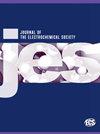Electrochemical Nanomolar Determination of the Anticancer Drug 5-Fluorouracil Using Chitosan Curcumin Schiff Base-Decorated NiO Nanorods Synthesized with Green Method
IF 3.3
4区 工程技术
Q2 ELECTROCHEMISTRY
引用次数: 0
Abstract
5-Fluorouracil (5-FU) is widely used in the treatment of various cancers, necessitating accurate and sensitive detection techniques. Hybrid materials, combining organic and inorganic components, offer superior electrochemical characteristics, including enhanced conductivity and stability. Herein, NiO nanorods (NiONRs) were synthesized using用绿色方法合成的壳聚糖-姜黄素-席夫碱装饰的氧化镍纳米棒电化学测定抗癌药物 5-氟尿嘧啶的纳摩尔浓度
5- 氟尿嘧啶(5-FU)被广泛应用于各种癌症的治疗,因此需要精确灵敏的检测技术。混合材料结合了有机和无机成分,具有优异的电化学特性,包括更强的导电性和稳定性。本文利用莽草叶提取物合成了氧化镍纳米棒(NiONRs),并用壳聚糖姜黄素类似物席夫碱(Cs-Cur-A)进行了装饰。通过傅立叶变换红外光谱(FT-IR)、1HNMR、XRD、SEM 和 EDX 等不同技术研究了 NiONRs 和 Cs-Cur-A 的特性。利用 Cs-Cur-A/NiONRs 修饰的玻璃碳电极(GCE),阐明了一种测定 5-FU 的灵敏、选择性电化学传感器。在 pH 值为 7.0、扫描速率为 50 mV s-1 的 Cs-Cur-A/NiONRs/GCE 上,5-FU 的阳极峰值电流大大提高。根据计时器测量,扩散系数(D)估计值为 2.96 × 10-6 cm2 s-1。利用差分脉冲伏安法(DPV),制备的传感器具有较宽的线性范围(0.1-150.0 μM)和较低的检测限(21.75 nM)。此外,该传感器还成功地应用于血清和尿液样品中 5-FU 的检测,具有很高的重现性、可重复性和选择性。
本文章由计算机程序翻译,如有差异,请以英文原文为准。
求助全文
约1分钟内获得全文
求助全文
来源期刊
CiteScore
7.20
自引率
12.80%
发文量
1369
审稿时长
1.5 months
期刊介绍:
The Journal of The Electrochemical Society (JES) is the leader in the field of solid-state and electrochemical science and technology. This peer-reviewed journal publishes an average of 450 pages of 70 articles each month. Articles are posted online, with a monthly paper edition following electronic publication. The ECS membership benefits package includes access to the electronic edition of this journal.

 求助内容:
求助内容: 应助结果提醒方式:
应助结果提醒方式:


